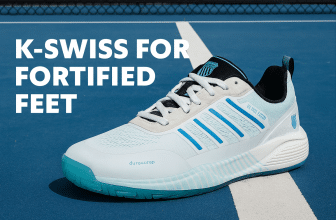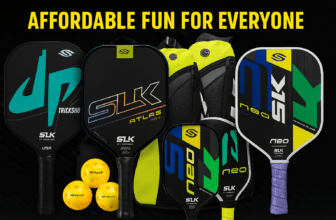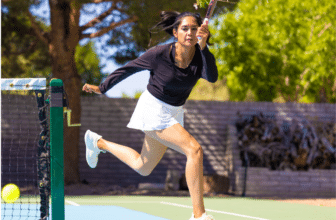The sport of pickleball has seen an impressive surge in popularity, bringing with it an evolution of play that includes faster and more explosive serves. The Chainsaw Serve ban was supposed to give the edge back to the returner, but servers are relentless, and what they can’t do with spin, they’re doing with speed.
Managing these serves can be intimidating, especially for beginners and intermediate players. But fear not because there are strategies and techniques you can learn to counteract these challenging serves and turn them to your advantage. Here’s a thorough guide on how to effectively return fast pickleball serves and keep control of the game.
Understanding the Serve in Pickleball
Before we dive into returning serves, let’s understand the serve’s purpose in pickleball. Unlike tennis, the serve in pickleball isn’t typically a weapon used to score direct points. The serving etiquette demands an underarm motion, leading to more strategic play right from the serve. However, as players advance, they find ways to increase the power and speed of their serves, which can be daunting to return.
How Fast is the Fastest Pickleball Serve

The seeming discrepancy between the theoretical maximum serve speed and the serve speed of elite pickleball players can be intriguing. The theoretical maximum speed of around 40 mph, as mentioned, refers to the upper limit of serve speed under ideal conditions, taking into account factors like aerodynamics, the physical properties of the ball, and the rules of the game. This speed ensures that the ball doesn’t sail beyond the baseline or hit the net.
However, the mention of elite players reaching speeds of up to 70 mph might be attributed to exceptional skill, technique, or power, possibly even including a bit of exaggeration or inaccuracy in reporting. It’s also possible that these higher speeds are achieved in situations that don’t align perfectly with the theoretical model, such as varying environmental conditions (like wind) or slightly different serve techniques that still conform to the rules of the game but aren’t considered in the theoretical mode.
Preparation Is Key
Returning fast serves begins well before the serve is struck. Preparation includes both physical readiness and mental foresight. Position yourself correctly within the service court, usually near the baseline center, giving you ample room to move in any direction. Keep your knees bent, and your weight leaning slightly forward with your paddle raised at chest level. This stance ensures you are in the best possible position to react.

Mental preparation comes next. It’s essential to get into the mindset that every point counts. By doing so, you’re less likely to be caught off-guard by a quick serve.
The Grip
Having the right grip on your paddle is crucial. A continental grip, similar to holding a hammer, typically provides the most flexibility and quickest response time. It allows you to easily transition between forehand and backhand without changing your hand position, which is invaluable for those split-second reactions needed to return fast serves.

Read Your Opponent
Anticipation is a significant advantage in pickleball. Watch your opponent carefully. Often, players have tells or habits that signal a fast serve. This could be the position of their feet, the grip on their paddle, or even how they toss the ball. By learning to recognize these signs, you can anticipate a fast serve and mentally prepare your return before the ball is even in play.
The Return
Timing
When a fast serve comes your way, remember that timing is everything. Start your paddle back early in preparation to meet the ball. You want to hit it at the apex of the bounce to give yourself more control and reduce the chance of hitting a high return that could set up your opponent for a winning shot.
Paddle Angle
A fast serve will have a lot of forward momentum. By angling your paddle slightly upward upon contact, you can use the serve’s speed to direct it back over the net with the minimum required effort. This conversion of energy can be your best friend when dealing with powerful serves.
Body Position

If a serve is coming at you fast, ensure you are sidestepping rather than moving backward to make contact. It’s easier to control your paddle and return a serve when your body weight is moving forward or is stationary compared to when you’re backpedaling.
The Two-Shot Strategy
A beneficial strategy when faced with fast serves is to think two shots ahead. The first shot, your return, should set you up for a good second shot, usually a third-shot drop to the kitchen. Aim your return deep into your opponent’s court, which will help you gain valuable time to position yourself for what comes next.
Drill-specific Training
Side-to-Side Drills
Practicing with a partner or coach and having them serve to you alternatively at your forehand and backhand will help you build reaction time and adaptability.
Return Depth Drills
Have your training partner serve fast balls while you focus on returning them deep. This will force you to get comfortable with fast serves and allow you to work on placing your returns effectively.
Solo Wall Drills
A wall can be your best teacher. By rapidly hitting against a wall, you simulate the fast pace and get used to the speed. Try returning the ball at different angles and heights to mimic in-game situations.
Conditioning Your Mind and Body
While drills and strategy are critical, none of it will matter if you’re not in the right shape, both physically and mentally. Physical conditioning, such as agility and core strength exercises, will enhance your ability to move quickly and maintain balance. Mental conditioning, through visualization and mindfulness exercises, can help you maintain focus and reduce anxiety, ensuring you’re ready for whatever serve comes flying over the net.
Study the Game
You can learn a lot from watching others. Study games of top players, particularly how they return fast serves.
Final Thoughts
Returning fast serves in pickleball doesn’t necessarily require brute strength; it needs finesse, anticipation, and the right technique. By preparing your stance, reading your opponent’s cues, and practicing specific drills, you will improve your ability to return even the most challenging serves.
Remember that pickleball is as much about mental warfare as it is about physical prowess. Keeping a clear head, practicing patience, and not getting frustrated with yourself when you miss are all part of the learning process. Each point, each game, and each play session is an opportunity to better your return game. Equip yourself with reliable gear by checking out “Best Graphite Paddles for New Players” and go out there and face those fast serves with confidence!
Lastly, don’t forget to enjoy the process. Pickleball is about community, competition, and fun. With time and practice, returning fast serves will become just another part of this thrilling game that we enjoy with friends and competitors alike. So, grab your paddle, your can-do attitude, and let’s hit the courts – it’s pickleball time!
- Foam-“Powered” Performance: Why CRBN’s TruFoam Genesis Series Could Be the Future of Pickleball Paddles - April 16, 2025
- Advanced Pickleball Players Always Perfect These 3 SIMPLE Skills – See How You Can Too! - May 17, 2024
- Selkirk Halo Power XL Playtester Review| Affordable Raw Carbon - May 7, 2024








